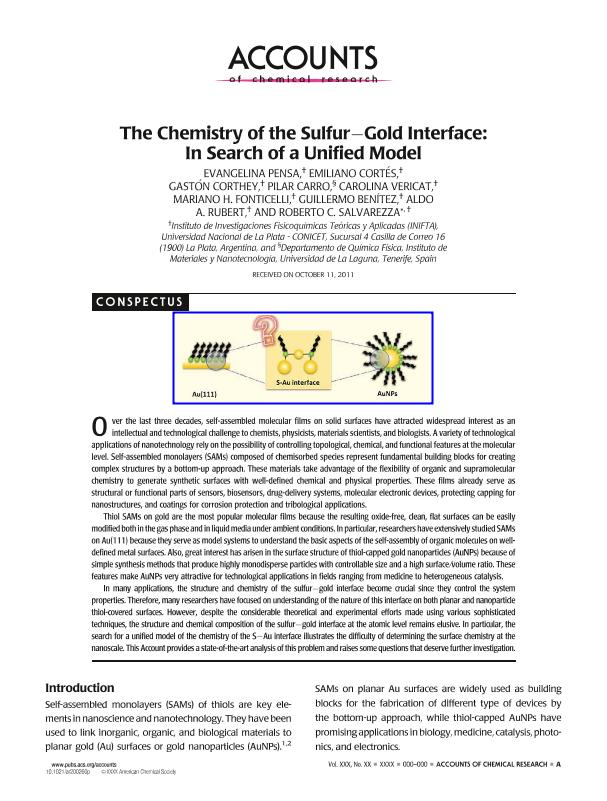Mostrar el registro sencillo del ítem
dc.contributor.author
Pensa, Evangelina Laura

dc.contributor.author
Cortés, Emiliano

dc.contributor.author
Corthey, Gastón

dc.contributor.author
Carro, Pilar

dc.contributor.author
Vericat, Carolina

dc.contributor.author
Fonticelli, Mariano Hernan

dc.contributor.author
Benitez, Guillermo Alfredo

dc.contributor.author
Rubert, Aldo Alberto

dc.contributor.author
Salvarezza, Roberto Carlos

dc.date.available
2020-05-05T17:53:52Z
dc.date.issued
2012-03
dc.identifier.citation
Pensa, Evangelina Laura; Cortés, Emiliano; Corthey, Gastón; Carro, Pilar; Vericat, Carolina; et al.; The Chemistry of the Sulfur-Gold Interface: In Search of a Unified Model; American Chemical Society; Accounts of Chemical Research; 45; 3-2012; 1183-1192
dc.identifier.issn
0001-4842
dc.identifier.uri
http://hdl.handle.net/11336/104263
dc.description.abstract
Over the last three decades, self-assembled molecular films on solid surfaces have attracted widespread interest as an intellectual and technological challenge to chemists, physicists, materials scientists, and biologists. A variety of technological applications of nanotechnology rely on the possibility of controlling topological, chemical, and functional features at the molecular level. Self-assembled monolayers (SAMs) composed of chemisorbed species represent fundamental building blocks for creating complex structures by a bottom-up approach. These materials take advantage of the flexibility of organic and supramolecular chemistry to generate synthetic surfaces with well-defined chemical and physical properties. These films already serve as structural or functional parts of sensors, biosensors, drug-delivery systems, molecular electronic devices, protecting capping for nanostructures, and coatings for corrosion protection and tribological applications. Thiol SAMs on gold are the most popular molecular films because the resulting oxide-free, clean, flat surfaces can be easily modified both in the gas phase and in liquid media under ambient conditions. In particular, researchers have extensively studied SAMs on Au(111) because they serve as model systems to understand the basic aspects of the self-assembly of organic molecules on welldefined metal surfaces. Also, great interest has arisen in the surface structure of thiol-capped gold nanoparticles (AuNPs) because of simple synthesis methods that produce highly monodisperse particles with controllable size and a high surface/volume ratio. These features make AuNPs very attractive for technological applications in fields ranging from medicine to heterogeneous catalysis. In many applications, the structure and chemistry of the sulfurgold interface become crucial since they control the system properties. Therefore, many researchers have focused on understanding of the nature of this interface on both planar and nanoparticle thiol-covered surfaces. However, despite the considerable theoretical and experimental efforts made using various sophisticated techniques, the structure and chemical composition of the sulfurgold interface at the atomic level remains elusive. In particular, the search for a unified model of the chemistry of the SAu interface illustrates the difficulty of determining the surface chemistry at the nanoscale. This Account provides a state-of-the-art analysis of this problem and raises some questions that deserve further investigation.
dc.format
application/pdf
dc.language.iso
eng
dc.publisher
American Chemical Society

dc.rights
info:eu-repo/semantics/openAccess
dc.rights.uri
https://creativecommons.org/licenses/by-nc-sa/2.5/ar/
dc.subject
GOLD
dc.subject
SULFUR
dc.subject
INTERFACE
dc.subject
SELF ASSEMBLED MONOLAYERS
dc.subject.classification
Físico-Química, Ciencia de los Polímeros, Electroquímica

dc.subject.classification
Ciencias Químicas

dc.subject.classification
CIENCIAS NATURALES Y EXACTAS

dc.title
The Chemistry of the Sulfur-Gold Interface: In Search of a Unified Model
dc.type
info:eu-repo/semantics/article
dc.type
info:ar-repo/semantics/artículo
dc.type
info:eu-repo/semantics/publishedVersion
dc.date.updated
2020-03-16T15:00:16Z
dc.journal.volume
45
dc.journal.pagination
1183-1192
dc.journal.pais
Estados Unidos

dc.journal.ciudad
Washington
dc.description.fil
Fil: Pensa, Evangelina Laura. Consejo Nacional de Investigaciones Científicas y Técnicas. Centro Científico Tecnológico Conicet - La Plata. Instituto de Investigaciones Fisicoquímicas Teóricas y Aplicadas. Universidad Nacional de La Plata. Facultad de Ciencias Exactas. Instituto de Investigaciones Fisicoquímicas Teóricas y Aplicadas; Argentina
dc.description.fil
Fil: Cortés, Emiliano. Consejo Nacional de Investigaciones Científicas y Técnicas. Centro Científico Tecnológico Conicet - La Plata. Instituto de Investigaciones Fisicoquímicas Teóricas y Aplicadas. Universidad Nacional de La Plata. Facultad de Ciencias Exactas. Instituto de Investigaciones Fisicoquímicas Teóricas y Aplicadas; Argentina
dc.description.fil
Fil: Corthey, Gastón. Consejo Nacional de Investigaciones Científicas y Técnicas. Centro Científico Tecnológico Conicet - La Plata. Instituto de Investigaciones Fisicoquímicas Teóricas y Aplicadas. Universidad Nacional de La Plata. Facultad de Ciencias Exactas. Instituto de Investigaciones Fisicoquímicas Teóricas y Aplicadas; Argentina
dc.description.fil
Fil: Carro, Pilar. Universidad de La Laguna; España
dc.description.fil
Fil: Vericat, Carolina. Consejo Nacional de Investigaciones Científicas y Técnicas. Centro Científico Tecnológico Conicet - La Plata. Instituto de Investigaciones Fisicoquímicas Teóricas y Aplicadas. Universidad Nacional de La Plata. Facultad de Ciencias Exactas. Instituto de Investigaciones Fisicoquímicas Teóricas y Aplicadas; Argentina
dc.description.fil
Fil: Fonticelli, Mariano Hernan. Consejo Nacional de Investigaciones Científicas y Técnicas. Centro Científico Tecnológico Conicet - La Plata. Instituto de Investigaciones Fisicoquímicas Teóricas y Aplicadas. Universidad Nacional de La Plata. Facultad de Ciencias Exactas. Instituto de Investigaciones Fisicoquímicas Teóricas y Aplicadas; Argentina
dc.description.fil
Fil: Benitez, Guillermo Alfredo. Consejo Nacional de Investigaciones Científicas y Técnicas. Centro Científico Tecnológico Conicet - La Plata. Instituto de Investigaciones Fisicoquímicas Teóricas y Aplicadas. Universidad Nacional de La Plata. Facultad de Ciencias Exactas. Instituto de Investigaciones Fisicoquímicas Teóricas y Aplicadas; Argentina
dc.description.fil
Fil: Rubert, Aldo Alberto. Consejo Nacional de Investigaciones Científicas y Técnicas. Centro Científico Tecnológico Conicet - La Plata. Instituto de Investigaciones Fisicoquímicas Teóricas y Aplicadas. Universidad Nacional de La Plata. Facultad de Ciencias Exactas. Instituto de Investigaciones Fisicoquímicas Teóricas y Aplicadas; Argentina
dc.description.fil
Fil: Salvarezza, Roberto Carlos. Consejo Nacional de Investigaciones Científicas y Técnicas. Centro Científico Tecnológico Conicet - La Plata. Instituto de Investigaciones Fisicoquímicas Teóricas y Aplicadas. Universidad Nacional de La Plata. Facultad de Ciencias Exactas. Instituto de Investigaciones Fisicoquímicas Teóricas y Aplicadas; Argentina
dc.journal.title
Accounts of Chemical Research

dc.relation.alternativeid
info:eu-repo/semantics/altIdentifier/url/http://pubs.acs.org/action/doSearch?action=search&author=Rubert&qsSearchArea=author&type=within&publication=40025951
dc.relation.alternativeid
info:eu-repo/semantics/altIdentifier/doi/http://dx.doi.org/10.1021/ar200260p
Archivos asociados
